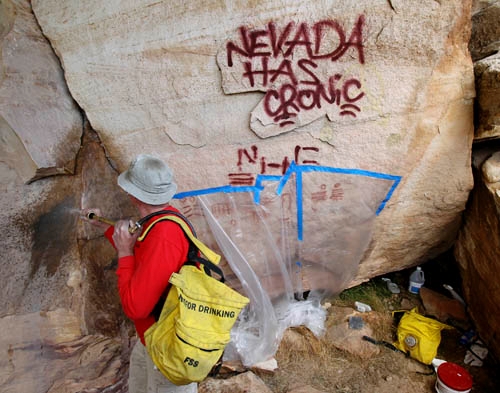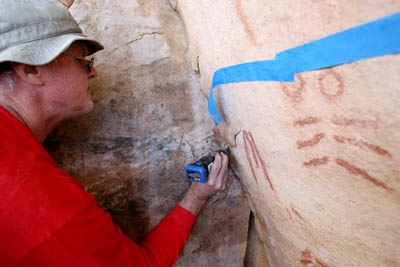Volunteers work to rid Red Rock petroglyph site of graffiti
Call it the art of saving art.
When the graffiti taggers ventured into the Red Rock Canyon National Conservation Area's Lost Creek area in the fall, they might not have realized the canvas they chose to deface was home to 1,000-year-old petroglyphs and pictographs, etched or painted into ancient sandstone.
Or perhaps they knew exactly what they were doing and chose such a delicate site to add gravitas to their social commentary -- for example, the words "Nevada has cronic," slang for potent marijuana.
The spray-paint vandalism is extensive; it is clear the offenders had time and isolation on their side.
And while each piece of damage was likely done in less than an hour, cleaning up the mess has taken half a year and the work is weeks from completion.
Fortunately, the Friends of Red Rock Canyon's army of volunteers, Bureau of Land Management employees, and one world-renowned rock art restoration expert have managed to remove most of the damage.
The area is a sacred one to the local Paiute tribe -- archaeologists believe it was a Paiute who drew the abstract series of lines and circles a millennium ago -- and it is a spiritual place for hikers, bikers and anyone else who appreciates natural history.
Removing the spray paint would be a simple affair if harsh solvents could be used, but the goal is to remove the graffiti while saving the petroglyphs and pictographs.
"We start with a dry treatment," said Jannie Laubser, a South African archaeologist who specializes in rock art. "That hardly ever works with spray paint, so then we go with native water, and if that doesn't work we use denatured alcohol."
The process, much like an archaeological dig that requires patience and a keen eye to detail, is further complicated by the geologic makeup of the canyon.
The rock changes from soft and porous to hard as granite. The sandstone has been around about 65 million years, give or take a decade or two, and is protected by the Keystone and Spring Mountains ranges that shield if from some of the desert Southwest's more hostile weather.
The tools of the trade are not what one could call heavy industrial. "We use Q-tips, dental picks, even Dremels to get into hard-to-reach areas," Laubser said.
Police arrested a 17-year-old "tagger" known as Pee Wee in December.
His name has not been released because of his age, but Pee Wee is considered one of the valley's more prolific taggers. He is believed to be affiliated with the Nasty Habits Crew.
Laubser admitted he holds a grudging respect for Pee Wee's artistic talent. "The guy's good," he said. "Some of his stuff is real good, he has a good hand."
As an archaeologist, Laubser said today's graffiti tagger might be studied by tomorrow's social scientists.
The difference between today's taggers, considered vandals, and yesterday's artists is one of acceptance, he said.
"The Indians who did this were culturally sanctioned," he said. "Graffiti is not sanctioned. I see it as art, but art in the wrong place."
Laubser said Americans have engaged in graffiti for decades. He said they removed some of it near a site that dated back to the 1950s.
His expertise has allowed him to see the world while consulting on graffiti cleanup projects from Peru to Utah.
BLM archaeologist Mark Boatwright said the good news is that removing graffiti has proved easier than thought.
Nature, wind and rain, will take care of a lot of problems over time, but not even weather and a good scrubbing will ever return defaced cultural sites to their original condition.
"It will never be the same, but at least now you would have to know what you're looking for to see it," he said.
Unfortunately, graffiti is on the rise, with other types of malicious destruction of ancient cultural artifact. Figuring out how to remove it from various surfaces has been a learning experience.
Contact reporter Doug McMurdo at dmcmurdo@review journal.com or 702-224-5512.





























